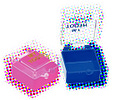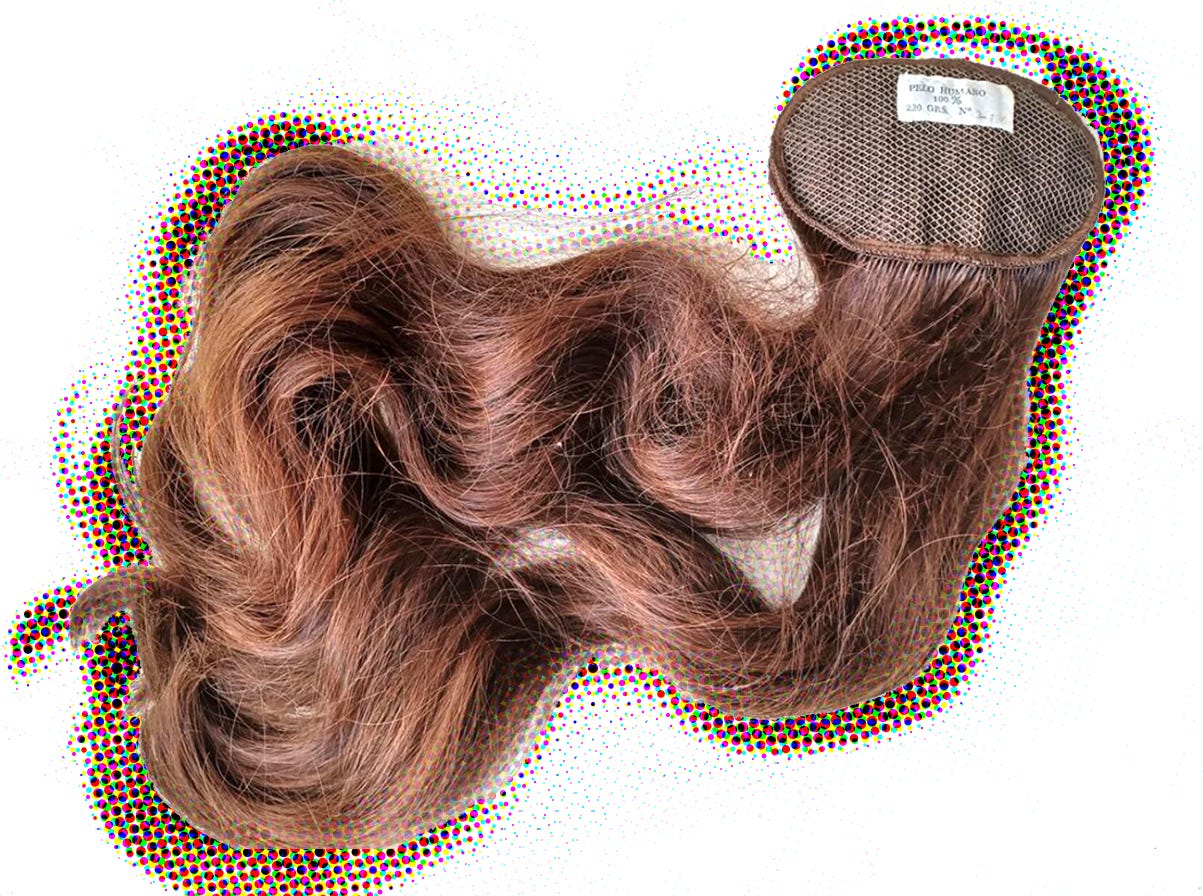I found them when I was cleaning out my shirts drawer. Well, one of my shirts drawers, because for some reason I have so many shirts that they don’t all fit in one drawer. This is why I was cleaning one of them out. That, and the fact that the drawer is in a dresser in a room that is about to change, because we are putting down new flooring, which means moving everything out.
Which means touching everything.
Which means thinking about everything.
So today I am thinking about hair and teeth, because that is what I found in my shirts drawer. Hair and teeth.
The teeth were tiny and sharp. I looked at the first tooth upside-down at first, and wondered whose teeth were so sharp and so hollow. Then I realized I had it all wrong, and I was looking at the root.
The tooth had fallen out of my daughter’s head, as tiny teeth do, some years earlier in that same room, back when it had been a bedroom, when the walls were covered with sticky decals of monkeys and trees and giraffes and balloons that were always peeling off and getting lost behind the bed.
The bed was so tall that she had to climb on a chair to get up to it at first. The chair sat next to the bed. At bedtime, I sat in the chair and sang three songs to help her fall asleep. First was “Red River Valley.” It’s an old song but I’ve only ever heard one version, by the Delmore Brothers, so that’s the one I sang. Next was “The Big Rock Candy Mountain,” the version from the “O Brother Where Art Thou” soundtrack. Last came “Yodeling Cowboy,” by Jimmie Rodgers. If a fourth song was ever needed, I would sing “Last Night I Had The Strangest Dream” by Simon and Garfunkel.” But usually it was just three.
Won't you think of the valley you're leaving,
Oh, how lonely and sad it will be,
Just think of the fond heart you're breaking,
And the pain you will cause me to see.
The first time she lost a tooth, I crept back into the room, dark except for a small night light, to slip my hand slowly underneath her pillow to search for what she had left for the Tooth Fairy. She refused money as a suitable reward, so the Tooth Fairy left behind colorful pencils, stickers, and once, Pixy Stix.
I remember slipping the tooth into my pocket and then, of course, forgetting it, finding it again later that night or the next day. A tiny piece of the human that I had created inside my body. That tooth had grown, first inside me, as part of her. And now I was holding it in my hand. I folded it up in a slip of paper and shoved it into the back of my dresser drawer, because, well, what do you do with a tooth?
What do you do with a tooth?
My parents’ linen closet is a huge cupboard that takes up most of one wall. For several years, my bedroom was in the room where the linen closet was, so I became very familiar with its contents. Blankets, sheets and pillows, yes; but also board games and photo albums and old notebooks and Band-Aid boxes full of rocks and a half-finished latchhook rug.
And a box, a beautiful cardboard box that smelled faintly of sandalwood and held a thick, heavy braid of my mother’s hair.
The braid lay coiled like a serpent in the box, which had previously held bars of soap. It nestled there, radiant. I loved to take down the box and marvel at the chestnut color of the braid, at the perfect curl that formed at the end of the braid, soft and tender around my fingers.
When my grandmother died, among her things were two round boxes, like hat boxes, but they contained falls: long tresses of hair anchored to a sort of peg at one end. These were used to enhance her natural hair into a suitably grand updo.
When I was given the chance to keep some of my grandmother’s things, I chose a few silk scarves and the two round boxes, which contained two different falls, one chestnut, one ash blonde.
I didn’t know what to do with them. I just thought they were beautiful, and they were hers, so I wanted to keep them. I used to hold them up next to my head and look in the mirror to imagine what I would look like with long, straight, flowing ash-blonde hair.
On my dresser was a small jewelry box — the kind made of cardboard covered in fabric, with a ballerina that popped up when you opened the lid. Inside the jewelry box was a small square case labeled MY TOOTH. Inside the case were two small teeth with very long roots, the product of an extraction. Small specks of blood clung to one of the roots. Until the extraction, I had not known that teeth grew such long roots.
In a plastic shopping bag at the back of my shirts drawer was a thick chunk of my own hair, my younger hair, cut off years before my daughter had been born.
Unlike my mother’s neat, thick braid, my discarded hair lay in an untidy swirl inside the plastic shopping bag, startlingly alive-looking. I held it in my hands like it was a small animal, and breathed in my own youth. How it glowed in the sunlight, unbroken by even a single strand of gray.
The last time I was at my parents’ house, my mother brought me the sandalwood-scented box holding the braid and held it out to me with a smile. “Do you know …” she started, but the sentence had no ending, as many of her sentences these days do not.
But it was all right. I did know. We opened the box together. There lay her thick, heavy, dark braid, still neatly coiled, at rest. Next to it was a smaller braid, one I had forgotten: a small, tight, short braid, not silken, not chestnut, but bleached to a color and texture like straw.
I remembered how my mother had used my dad’s clippers to shave most of my head bald, all but the bangs; how she had carefully mixed and applied the acrid-smelling bleach to the shock of hair that remained unshaven, and sat with me on the patio while the chemicals did their work. How she helped me rinse out the bleach, then dye it turquoise, then rinse out the turquoise a few days later. How she had helped me braid and trim the bleached lock when I was done with that look and ready to move on to the next. How she had always stood alongside me, through all of the disguises I tried on, patient and loving.
I tell my daughter she has her grandfather’s hair, she has my bad soft teeth, even down to the little spot on her front incisor. I have my mother’s hair, the Beistel hair: big soft waves, thick, unruly, as uncontrollable as a cat. Sometimes it seems I am my mother, and my daughter is me. I look at my mother and see, as I always have, the woman I will become.
How much has already been written? How many years will pass before my sentences end mid-stream as hers do now, cut short by words that have become irretrievable?
Time is a thief. The little girl climbing up into her big bed, whose mouth shed small sharp teeth, is nearly a teenager. The shorn-and-bleached teenager has become a middle-aged mom. The young mother whose braid lay thick and heavy and chestnut-colored over one shoulder is now a grandmother, but she does not always remember who I am, or who her granddaughter is. And the stylish grandmother, her head piled high with hair, is many years dead.
My shirts drawer is not cleaned out. I fold the teeth carefully back up into their small pieces of paper, put the hair back into the plastic shopping back, and tuck them back into the back of the drawer, because what do you do with a tooth? With hair? With the tiny bits of a person you once knew, you once were?
For now, I will keep them, hold them, feel them between my fingers, and remember the people they belonged to, who are still here but also gone. I will look into the mirror and see, at once, my own mother, my younger self, my daughter, my grandmother. We are all here, but also, we are gone or leaving. We cannot stay. We will leave behind things like hair and teeth so that we can be remembered.





This is beautiful and I can relate. I have hair clippings from my daughter’s first haircuts and teeth as well. I also cut off hair from my beloved dog when he passed. Why do we gather and keep these things? I’m not sure but I am comforted by them.
Beautiful. And heartbreaking. I think you're brave to open all those boxes and bags.